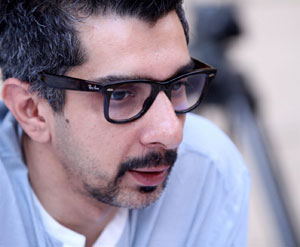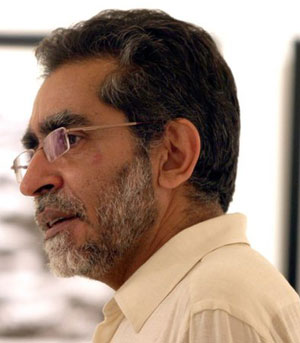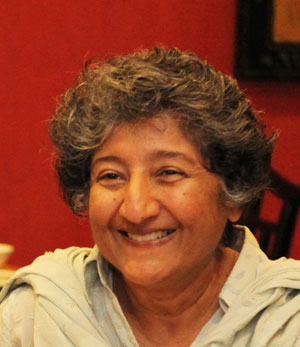Capturing the Moment
By Maheen Bashir | Arts & Culture | Published 15 years ago
“It has been a fabulous year for photography, not just in terms of books, but also in terms of a revolution in the profession,” says top photographer Tapu Javeri at the launch of Amean Jan’s new book. With two new photography books (Tapulicious and BHV ZOO), three exhibitions by senior photographers this month, and several group shows, he may be right.
A young and upcoming photographer Danish Khan sold his first picture internationally in 2005, but remains aloof from the local market. “No one really buys photography in Pakistan,” he says. There is no doubt that photography in Pakistan is a struggling art and there are very few serious buyers, but can this fledging art form gain appreciation in Pakistan, like it has done abroad?
Whereas art in the form of paintings has a head start of several decades, people slowly seem to be valuing photography as a true art form. Sara Farooqui, co-owner of Koel Gallery, agrees that photography is an art that is still being realised, but says that awareness is growing. Riffat Alvi, director of V.M. Gallery, held her first photography exhibition with veteran photographer Arif Mahmood in 1989, just two years after the opening of her gallery, and she feels that in the last two years photographers have surfaced on the art scene. Referring to the recent exhibit by senior photographer Tehmina Ahmed at her gallery, Riffat says photographs might not sell as rapidly as paintings, but we are not very far away from the point when they do.
A more optimistic outlook emerged from Ayesha, Arif Mahmood’s wife and owner of the first photo gallery in Pakistan, Photospace. “Photography is a struggling art, but we are right at the door, we have almost made it,” says Ayesha. Photospace opened just two years ago but has come at a time when the market for photographs is growing at a pace that merits a bigger gallery — Photospace is moving to Old Clifton, just opposite the Mohatta Palace in Karachi. In terms of pricing, Ayesha feels photographs are modestly priced, but Alvi hopes that will also slowly improve. Photographs at exhibitions have been priced between Rs 10,000 — 50,000, depending on the photographer and the number of prints per photograph. According to Ayesha, limited edition photographs, or one of a kind, hold higher value than other photographs. “The more serious buyers buy landscapes, but there are also genuine buyers for abstract photography and sometimes photojournalism,” explains Ayesha. While Sara Farooqui says landscapes sell more than any other photographs, Riffat agrees and adds that photographers are now exploring more serious concepts and are being appreciated for it. “Tehmina’s title piece, where she has shot her own feet, was widely appreciated,” says Riffat.
There were very few photographers in Pakistan until a few years ago, but now the pool seems to be expanding, says Riffat Alvi. What’s more, top photographers are supporting each other by turning up at each other’s exhibition and promoting it. Tapu Javeri gave the introductory speech at Amean Jan’s book launch, Asif Raza was seen at Tehmina Ahmed’s exhibition and Tapu and Arif Mahmood are fast friends. But what does this mean for the younger photographers?
Photospace, along with other galleries are committed to promoting new and young photographers. “We have Arif Mahmood’s Folio on Lal Shahbaz Qalandar coming up, but we promote young photographers as well,” says Ayesha. “Recently we held an exhibition of Kohi Marri and Ayaz Anis’s work, but we have also exhibited Nariman Ansari, Ali Khurshid and other upcoming ones,” she says.
Koel and V.M. Gallery hold at least two to three photography exhibitions every year and with the entry of Photospace in the market we will be seeing photographs in exhibitions every couple of weeks. Newsline looks at the three exhibitions this month.
* * *

Amean Jan
“Put yourself in their place,” reads the caption. Animals: elephants, lions and monkeys all come to see the Homo sapiens, probing and poking at the cages and enjoying their day out at the zoo. This is what Amean Jan wants you to keep in mind when walking through his exhibit. His photographic display of the Bahawalpur zoo at the Indus Valley School of Art and Architecture (IVSAA) evokes much more than just childhood memories.
Titled Life at Bahawalpur Zoo (BVH ZOO), the exhibit feels minimally edited and expertly composed. Amean’s composition of the frame within a frame in no.11 keeps the focus point powerful and concentrated. Some shots capture only part of the body of the animal, for instance the tiger disappearing around the pillar or the elephant going into its home (no.26), defying conventional composition. It grabs your attention immediately. A powerful shot of the monkey biting the bars, with its hand pressed against the cage, reveals the pain and suffering of animals in captivity, without proper care. The monkey stares back at us with eyes that are now devoid of any life.
The sheer magnificence and beauty of the animals is captured in poignant pieces that force one to stop and admire. The folios on birds, especially the one with the duck diving in the water and the stretched wings of the bird, take your breath away.
Amean has also explored other parts of the zoo and shows off his expertise in lighting and angles. A shot of the park’s bench from the back, with a ripple effect in the puddle of water on the pavement, captures the evening light brilliantly. Park vendors and visitors are also part of the exhibit with one particularly interesting shot of a group of burqa-clad women laughing and smiling.
“The book invokes a discussion on private spaces versus public spaces through the juxtaposition of the zoo as a public space for spectators and a private space for the inhabitant animals,” says Amean Jan about BHV ZOO. Along with his exhibit, Amean launched his coffee table book, e-book, postcards and photographs of BVH ZOO. All contributions from the sale have been pledged to WWF Pakistan. This was the first publishing venture by Markings, a brainchild of Kiran Aman.
* * *

Asif Raza
“There are no titles to any of the images. I am of the opinion that it is the individual viewers and their interpretation of any art that truly defines an image, its success or failure, and thus creates a title for a specific piece. I request you to take the time and give a title to the photographs,” implores Asif Raza. Titled, To Grasp the Scheme of Things Entire, Asif’s folio of 29 photographs is a strong testament to his focus and expertise in digital technology. The seasoned photographer, video professional, lecturer, entrepreneur and founder of Visage magazine, usually exhibits his work internationally, but this rare display of photographic excellence at the Koel Gallery was a treat for art lovers and comes at a time when photography is emerging on the art scene.
Asif Raza’s work captured the beauty of the seasons — the wilting leaves in autumn, the untouched, first snow of winter and the warm reflection of the sunset — with the exquisiteness of a painter. The moving water and gushing wind in the photographs came to life in the gallery and touched the senses of all who observed Asif’s work. From his reflections of the Japanese garden in autumn, to the golden and blue hues of the sunset, and the delicate footsteps in the snow, Asif’s attention to detail was undeniable. The maple tree branches and the shapes of the leaves spiralled like cocoons on the branches were very interesting to look at.
Asif’s angles and reflection of light in puddles of water were expertly shot. The colour purple in the high-resolution no.8 exuded the calmness and serenity of a twilight shot, which sparkled in the large horizontal frame. The plethora of colours dancing in the reflection of the water reminded one of Monet’s canvases.
Asif Raza, head and shoulders above most photographers in Pakistan, brings his experience and understanding of digital technology and aesthetic sense to his photographic canvas, and captures the viewers’ attention with one bold stroke.
* * *

Tehmina Ahmed
Tehmina Ahmed did not invest in PR, nor did she invite the city’s celebrities to open her first solo exhibition at V.M. Gallery, but her work speaks volumes for itself. Heading Newsline Films and a senior editor at Newsline, Tehmina has a decades-old affair with her camera and in the past it has translated to a few group shows, but she never could make the time to go solo. ‘Thresholds,’ Tehmina’s first solo venture in Karachi, comes after a solo show at the Nomad Gallery in Islamabad last year, and a group show in the US. It captures her journey through continents, with her camera, from the magnificent Wazir Khan Mosque in Lahore to the beaches near Santa Barbara, California.
“At what point does one begin to see? The frame is all around us,” asks Tehmina, enticing the viewer to delve into the picture, discovering and becoming part of the story behind the photograph. Her photographs have a poignant sensibility coupled with unique wit, captured best in a shot of a barber shop, titled ‘The Open Door.’ The sign painted on the shop’s door reads, “Welcome my dear, Thank you.” Tehmina captures and preserves magical sites and, according to Riffat Alvi, all who came to the exhibit praised her photograph showing young boys walking to school in Wah, outside Islamabad. Photographs of the Lahore Fort, Mochi Darwaza and a village temple in Kerala are beautifully unique in that they capture our heritage, telling a story of all that has passed. Minimally edited and with almost no use of Photoshop, Tehmina has displayed her mastery at capturing colours (orange hues of the sunset) or reflections (of a flower on a polished surface) drawing only from her talent and perspective.
“The photograph reflects reality as much as it shapes it. All around us, the phenomenal world goes its own way. The shutter chooses to freeze a particular slice of that world and in doing so gives it a life of its own,” says Tehmina, and her exhibit is a reminder of that as she gives meaning to the mundane, forcing us to stop and ponder. ‘The Garden is Green Again’ and ‘Through the Looking Glass’ are photographs from Tehmina’s sister’s home in Islamabad captured in the reflection of paintings hanging on the wall.
“The eye goes out for a walk and the photograph, in a sense, takes itself,” finishes Tehmina.
Click on any photo below to begin the slide show:
Maheen Bashir Adamjee is an APNS award-winning journalist. She was an editorial assistant at Newsline from 2010-2011.


